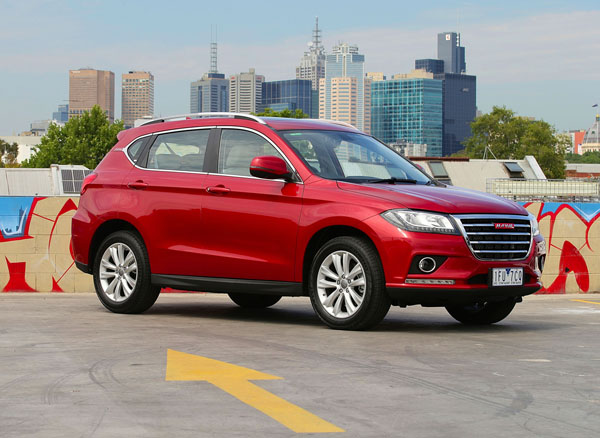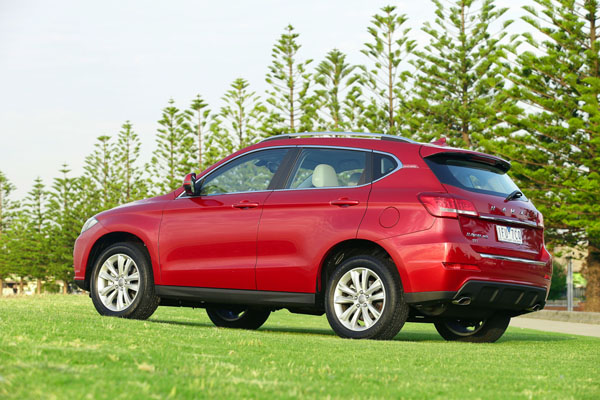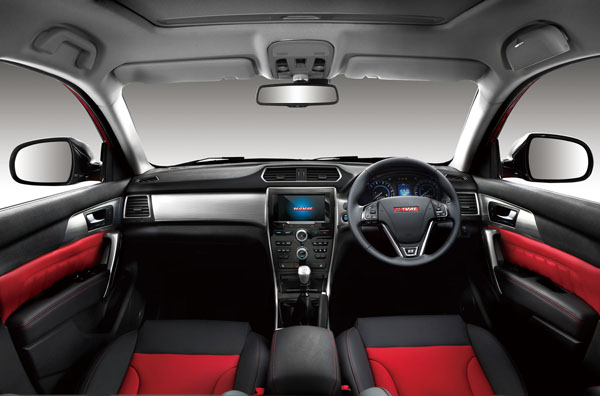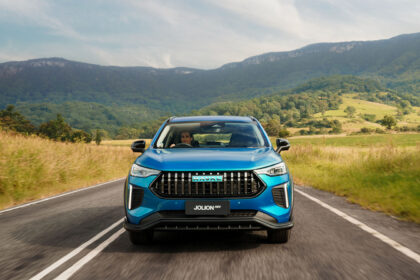
Haval’s ongoing improvement of the H2 sees the small sports utility vehicle pick up a range of advanced automotive systems. However, the Chinese-made compact SUV continues to fall short of the best in breed, such as the Mitsubishi ASX and Mazda CX-3.
What it does not lag behind in is the pricing, which can add up to $5000 or more for the entry-level model – in this case the Haval City 2WD manual at $19,990. The automatic City on test adds $1000.
Standard features include keyless entry and start, reverse parking sensors, cruise control, front and rear fog lights, LED daytime running lights, ambient interior lighting, heated front seats, rear privacy glass, and cloth trim.
STYLING
Nothing cute and swoopy about the Haval H2; it’s a flat nose and straight sides with a roof line that curtsies rather than bows at the back. The prominent wheel arches take standard 18-inch multi-spoke alloy wheels.
The rear features a roof spoiler with Haval badging across the hatch door and a diffuser with chrome exhaust tips on either side.
The large upright radiator grille is made up of horizontal chrome slats with sleek headlamp units running off on either side. Halogen main beams and reflector halogen high-beam units wear LEDs a-la string of pearls.
Foglamps are in a blacked-out area under the bumper, with another line of LED daytime running lights below. The top LEDs operate in tandem with the headlights, while the lower units come on when the headlights are off.
INTERIOR
Inside, the theme is basic 101. The dashtop is modern soft-touch but buttons and analogue instruments hark back years, as do cheap-feel standard cloth trim and plastic steering wheel.
Space is good enough not to cramp occupants, but four up is preferable to five. The Haval’s 300-litre cargo capacity is below average for the class but can be improved with the 60:40 rear seat backs folded.
The spare wheel is a full-size 18-inch steel rim with space-saving tyre.
INFOTAINMENT
The LCD screen is tiny by present-day standards and is situated underneath a CD slot. Graphics are sparse, while the air-con strip with temperature setting, is cramped.
The audio is four-speaker, with Bluetooth connectivity and single compact disc player. Unlike sound-muting in many cars, sound cuts out altogether when the car is in reverse. We don’t like that, believe us, designers we can actually listen to music and reverse at the same time.
A 3.5-inch screen between the tacho and speedometer displays fuel consumption and distance information, but no digital speed reading. And there’s not even a whisper of Apple CarPlay or Android Auto.
ENGINES / TRANSMISSIONS
The compact Haval H2 City auto is powered by a 1.5-litre turbocharged four-cylinder engine putting out 110 kW at 5600 rpm and maximum torque of 210 Nm 2200 rpm.
The motor is mated with a six-speed automatic transmission, putting power to ground through the front wheels.
SAFETY
Airbags add up to six – dual front, dual front side, and dual curtain – and the H2 City boasts ABS anti-locking brakes with brake assist, emergency brake distribution, electronic stability program, rear parking sensors, tyre-pressure monitoring and emergency braking lights.
But forget about autonomous emergency braking, lane keeping assistance, blind spot monitoring, rear cross-traffic alerts or adaptive cruise control. There’s no reversing camera.
The Haval H2 scored a maximum five-star ANCAP rating in 2017. It is debatable it would make the grade with today’s criteria.
DRIVING
They say patience is a virtue and the Haval H2 City automatic called on this from the word go. The SUV was slow to get off the mark and just as slow to get up to any sort of traffic speed, even with the right foot firmly planted. Filtering into moving traffic continued to be a chore. On the upside, the motor is quiet.
Premium petrol was a shock, and with test car fuel consumption topping 9 litres per 100 kilometres in the city and 5.3 on the motorway, put up running costs considerably.
Manoeuvring the Haval was without problems, but I did miss the reversing camera when parking. As for towing, the H2 is limited to 750 kg for an unbraked trailer and 1200 kg braked.
Cabin comfort was challenged by firm seating, while air-con turned out to be lottery. It was either ‘on’ or ‘off’, despite the control knob indicating a range of dial-up temperatures.
SUMMING UP
It you’re happy to forgo the finer things in Lilliputian SUV life, like touchscreen and reversing camera, digital radio and quality sound, and put up with premium petrol prices, the H2 could be for you. And don’t forget the sharp pricing and seven-year warranty.
AT A GLANCE
MODEL LINE-UP
Haval H2 City manual 2WD $19,990
Haval H2 City auto 2WD $20,990
Haval H2 Premium auto 4×2 $24,990
Haval H2 Premium auto 2WD $24,990
Haval H2 Lux auto 4×2 $26,990
Haval H2 Lux auto 2WD $26,990
Note: These prices do not include dealer or government charges. Contact your local Haval dealer for drive-away prices.
SPECIFICATIONS:
(Haval H2 City 1.5-litre four-cylinder direct injection turbocharged petrol engine, automatic 2WD SUV)
Capacity: 1497 cc
Configuration: 1.5-litre, 4 cylinder, six-speed automatic
Maximum Power: 110 kW @ 5600 rpm
Maximum Torque: 210 Nm @ 2200 rpm
Fuel type: Petrol 95 RON
Combined Cycle (ADR 81/01): 9 litres per 100 km
CO2 emissions 208 g / km
DRIVELINE:
Drivetrain: Six-speed automatic, front-wheel drive
DIMENSIONS, WEIGHT AND CAPACITIES:
Length: 4335 mm
Width: 1814 mm
Height: 1695 mm
Wheelbase: 2560 mm
Kerb weight: 1529 kg
Fuel Tank Capacity: 55 litres
BRAKES:
Front: Ventilated disc
Rear: Disc
WARRANTY:
7 years / unlimited kilometres













